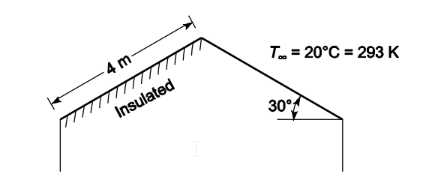How would the solar system be different today if the entire planet forming disk had been warmer than 300K? Why?
What will be an ideal response?
There would likely be fewer, or even no, gas giants. Astronomers think that the formation of ices at temperatures less than about 300 K was necessary to form large planetary "seeds" quickly enough to capture gas from the planet forming disk.
You might also like to view...
If the diffusivity of radon gas into nitrogen gas at 20ºC, 1 atm pressure is 0.12 cm^2/s, what would you expect the diffusivity to be at 30ºC, 2 atm pressure?
What will be an ideal response?
Solar radiation at 600 W/m2 is absorbed by a black roof inclined at 30°C as shown. If the underside of the roof is well insulated, estimate the maximum roof temperature in Tinf= 20°C air.
GIVEN
• Inclined roof, well insulated on the underside
• Incline angle (?) = 30 degrees
• Air temperature = 20°C
• Solar radiation absorbed (qs) = 600 W/m2
FIND
• The maximum roof temperature
ASSUMPTIONS
• The roof behaves as a black body (? = 1.0)
• The sky behaves as a black body at 0 K
SKETCH

PROPERTIES AND CONSTANTS
The Stephan-Boltzmann constant (?) = 5.67 × 10–8 W/(m2 K4).
A 400-g piece of metal at 120.0°C is dropped into a cup containing 450 g of water at 15.0°C. The final temperature of the system is measured to be 40.0°C
What is the specific heat of the metal, assuming no heat is exchanged with the surroundings or the cup? The specific heat of water is 4190 J/(kg?K). A) 1470 J/(kg ? K) B) 2830 J/(kg ? K) C) 3420 J/(kg ? K) D) 3780 J/(kg ? K) E) 4280 J/(kg ? K)
To be dimensionally consistent, velocity [L/T], force  mass [M], and length [L] must be related as follows.
mass [M], and length [L] must be related as follows.
A. 
B. 
C. 
D. velocity = force length/mass